Abstract
Whether an enterprise has a positive attitude towards social responsibility and whether it takes actions to assume social responsibility is very important to its sustainable development. The act of not taking social responsibility is not only an important reason for the lack of long-term development of enterprises, but also a key problem that hinders China’s further promotion of sustainable economic development. Therefore, it is very necessary to implement the corporate social responsibility regulatory system. The purpose of this paper is to examine the link between corporate social responsibility regulation and sustainable corporation law pathways. In order to explore this relationship and whether the two support each other, a TOPSIS-grey relational analysis is proposed. The experimental results of this paper show that the use of grey relational analysis (GRA) can evaluate whether the sustainable corporation law pathway has an impact on the practice of corporate social responsibility, and the accuracy rate is as high as 85%. The relationship between sustainable corporation law and corporate social responsibility is complementary, and the relationship between the two has reached more than 80%. Based on the path of sustainable corporation law, through the implementation of the regulatory system, enterprises can better undertake social responsibilities, thus promoting the comprehensive, sustainable and healthy development of enterprises. Only based on the principles of the sustainable corporation law pathway can businesses get better and better.
1. Introduction
The global and increasingly fierce corporate social responsibility movement is to promote enterprises to give back to society with ethical and moral actions while enjoying the freedom and opportunities given by society. Global corporate social responsibility and corporate culture complement, influence and develop together. After the Wenchuan Earthquake, people pay more attention to whether enterprises should undertake social responsibilities. Many companies have donated money and made large donations to disaster charities. Consumers can see that a responsible corporate image has attracted more attention and pursuit from the market in a short period of time, increasing the value of the brand. On the contrary, donating only CNY 10,000 will inevitably put the enterprise in trouble and seriously damage its image. The Sanlu poisonous milk powder incident made people feel the heavy social responsibility. It is not only an obligation of the enterprise on a moral level, but more importantly, it is related to its existence and development. Whether an enterprise undertakes social responsibility plays an important role in its sustainable development. Conversely, if the enterprise can realize the path of sustainable corporation law, it can promote it to undertake social responsibility. Both of them can supervise and promote each other.
The enterprise is an organization in a society, and this society exists in the unit of the state. Therefore, for a country, the enterprise is the organization of the state. Thus, the external responsibility of the enterprise is to obey the will of the state. With the development of the Internet and the advent of economic globalization, the pace of development and diversification of corporate social responsibility theory and practice in China must be accelerated. Corporate social responsibility has improved the relationship between the enterprise, the government, and society, formed a benign interaction between them, and created a broader living space for itself. In order to protect the environment and the interests of consumers, and maintain social stability, government departments have put forward various restrictions on behavior, sometimes accompanied by severe punitive measures. If an enterprise can take the initiative to undertake its due social responsibilities, there is no need to worry about the inspection and punishment related to it. In fact, this not only relieves some restrictive clauses in the development process of the enterprise to a certain extent, but more importantly, it makes the decision-making and operation of the enterprise have greater flexibility and autonomy. It is beneficial to both business interests and social interests by maximizing the path to sustainable corporation law. The innovation of this paper is to study the relationship between sustainable corporation law pathway and corporate social responsibility, and use grey relational analysis to analyze this relationship. Finally, the experiment is carried out and it is concluded that the sustainable corporation law pathway and corporate social responsibility are complementary results.
2. Related Work
Corporate social responsibility has developed rapidly. Many companies are actively taking social responsibility, but many are also avoiding it. Kearins, K. critically analyzed the relationship between contemporary corporate social responsibility and sustainability. Corporate social responsibility and sustainability are liberating, but they are defined by narrow business interests. Corporate social responsibility and sustainability aim to legitimize the power of large corporations [1]. Flammer, C. examined whether corporate social responsibility (CSR) can improve a company’s competitiveness in the marketplace. He found that CSR helped mitigate information asymmetry by signaling credibility, which suggested that CSR can serve as a differentiating strategy to compete with other bidders [2]. Muslu, V. found that due to the voluntary nature of corporate social responsibility, there was a big difference between the information content of corporate social responsibility reports and reality, and this content could help improve the accuracy of corporate development forecasts [3]. Gupta, A. found that companies’ positions on corporate social responsibility varied widely. He found that previous research by scholars that emphasized the role of external pressures and paid little attention to corporate social responsibility may also stem from corporate beliefs that prevail. It has also been found that ideology can predict the progress of CSR [4]. Vo, L.C. found that the corporate social responsibility movement had attracted a lot of attention in academia; however, people tend to focus on large organizations. Because SMEs play a vital role in the economy, their unique characteristics make them far from being applicable to the theory and practice of corporate social responsibility in large enterprises. Much research is needed to strengthen the CSR area of SMEs [5]. Scholars have found that social responsibility is very important for the development of enterprises. If an enterprise actively undertakes social responsibility, it will enable the enterprise to achieve sustainable and healthy development. However, if social responsibility is approached negatively, the development of the enterprise will not have long-term effects. But scholars have no concrete experiments to prove their conclusions.
With the vigorous development of data mining, people find that association rules can effectively analyze the relationship between things and process data efficiently. Berka, P. proposed a new method for post-processing of association rules based on the idea of meta-learning, which can help people better understand the association rules generated in the first step. Various types of association rules were defined and some benchmark data from machine learning repositories were reported. In evaluating the proposed method, grey relational analysis was used [6]. Wang, B. found that with the vigorous development of the economy, there is an urgent need for a powerful tool to maintain a comprehensive analysis of corporate sustainability. Grey association analysis is a prominent association rule learning method for exploring potential relationships in databases [7]. Wang, Y. found that with the enhancement of people’s awareness of environmental protection, it has become an important way for manufacturing enterprises to achieve sustainable development by improving environmental performance. Currently, one of the main challenges facing companies in environmental sustainability is to extend it to other supply chain members [8]. Zou, X. analyzed the factors that affect the acceptance of social responsibility by enterprises. A simple data mining algorithm was applied to calculate the association rules between these influencing factors and consumer acceptance in order to understand their relationship. The experimental results can help companies make decisions on whether to take social responsibility [9]. The research of various scholars has shown that association analysis can effectively discover whether there is a relationship between various data. Similarly, it can be applied to mining the relationship between sustainable corporation law pathway and social responsibility. The fly in the ointment is that scholars have no concrete data to prove the relationship between the two.
3. Social Responsibility Regulatory System Based on GRA
3.1. Corporate Social Responsibilities under Regulatory System
The concept of corporate social responsibility has increasingly attracted widespread attention in academia and its long-term value to social and economic development is self-evident. At present, the research focus around this field has shifted from the discussion of the origin and results of CSR to the process research on how CSR is formed and implemented, and on how stakeholders provide feedback [10]. In recent years, the relevant departments of the Chinese government have paid more and more attention to the supervision of listed companies. The content of corporate social responsibility is shown in Figure 1.
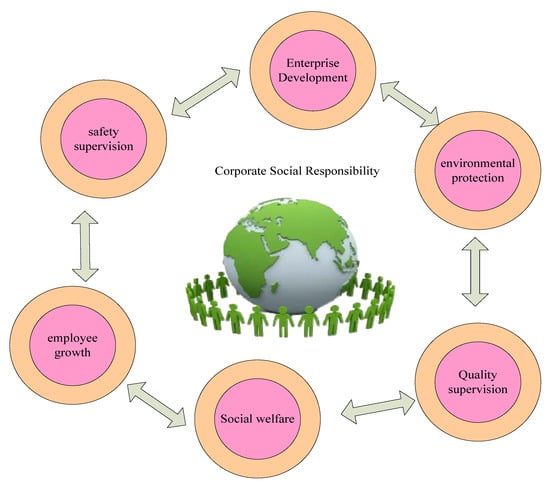
Figure 1.
Contents of CSR.
As shown in Figure 1, at present, China and even other countries in the world have no exclusive laws related to corporate social responsibility. Enterprises are related to multiple interests in the process of operation and are under the game of interests of all parties. All these factors are affecting the development of enterprises. Under the legal economy, it is very important for enterprises as managers and regulators to standardize and legalize various of their social responsibilities [11]. Compared with large, listed companies, most small- and medium-sized enterprises do not have the concept of public welfare responsibility, so they rarely participate in public welfare undertakings. First, SMEs do not contribute enough to the community. Generally speaking, SMEs tend to focus on their own economic benefits, rarely participate in community activities, and rarely communicate with the community. Even when the interests of the community conflict with the interests of the enterprise, enterprises tend to make choices that are beneficial to themselves, resulting in the failure to protect the interests of the community. Second, small- and medium-sized enterprises invest less in charity. Most small- and medium-sized enterprises do not assume social charity responsibility due to management or economic reasons.
From the perspective of employees, as the intangible assets of the enterprise they are invaluable treasures of the organization, and the attention and input to employees determine the development prospects of the enterprise. As a business enterprise, large-scale machinery, equipment, and chemical reagents are involved in the process of production and operation, so it has become a major problem for paying attention to the health and safety of employees [12]. At the same time, a certain proportion of funds are invested in employee education and training to promote their growth and exert greater value. In addition, enterprises also need to pay attention to the salary growth and welfare of employees, as well as to the employees themselves.
From the perspective of the environment, the production and operation of enterprises involve a large number of new materials, electronics, software, steel, and plastics, so special attention should be paid to environmental pollution [13]. Even in today’s economic development, as an economic group, enterprises still need to live in harmony with the environment in the entire social environment, natural environment and economic environment. Enterprises need to reduce pollution and use various resources efficiently.
3.2. Evaluation of Sustainable Corporation Law Pathway Based on GRA
- (1)
- Grey relational analysis
Grey relational analysis generally refers to the grey relational analysis method. Grey relational analysis is a very active branch of grey system theory. Its basic idea is to judge whether the connection between different sequences is close according to the similarity of the geometric shape of sequence curves. When the concept of grey relational analysis and evaluation was put forward, it caused great repercussions in the world. The advantage of the grey relational analysis method is that the sample size to be evaluated is flexible and the analysis and evaluation are not forced to obey the probability distribution [14]. The biggest difference from traditional analysis and evaluation methods is that grey relational analysis puts each evaluation factor in a unified environment for comparison as opposed to pairwise comparison analysis. Therefore, the grey relational analysis method is widely used in various fields and has important theoretical significance and practical value [15]. The grey relational analysis method is shown in Figure 2.
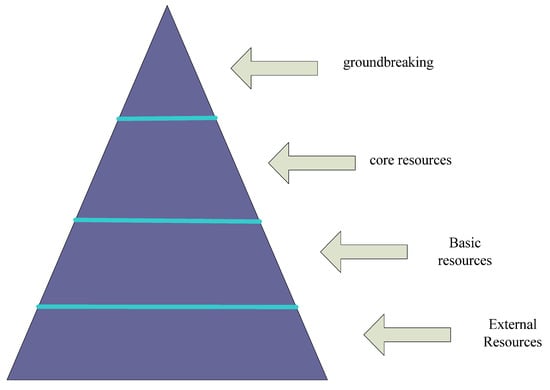
Figure 2.
Grey relational analysis structure diagram.
As shown in Figure 2, the basic steps are as follows. The problem is clarified: the scope of the research problem, the factors involved and the relationship between the factors are clarified, and the purpose is to collect and grasp the information [16]. A structural model is constructed: after in-depth analysis of the problem to be solved, the factors contained in the problem are divided into different levels according to their constraints. Grey relational analysis is a quantitative description and comparison method for the development and change of a system. Its basic idea is to judge whether the connection is close by determining the geometric similarity of reference data columns and several comparison data columns.
The specific operation steps of the grey relational analysis method are as follows: it is assumed that is the factor reference sequence of the evaluated scheme and the following is the factor comparison sequence of the evaluation scheme (Equation (1)):
The grey correlation degree of and is determined. There are many original data of correlation coefficient and the information is too scattered and difficult to compare. Therefore, the correlation coefficient at each instant must be concentrated on one value. The most efficient way to process this information is to take its average, as in Equation (2):
The evaluated schemes are sorted according to the grey relational degree . If , then the corresponding evaluation plan comparison sequence and are compared, and is closer to the optimal reference sequence. In the same way, the correlation degree can be obtained and the evaluation scheme can be sorted [17].
- (2)
- TOPSIS method
TOPSIS (pros and cons distance method) is a multi-attribute and multi-objective decision evaluation method. Its core point of view comes from the research on discrimination in the theory of multivariate statistical analysis. It is an optimal method to approximate the ideal point [18]. By sorting the pros and cons of the evaluation objects, the first step is to determine the positive ideal scheme and the negative ideal scheme of the evaluated object, and use this as the standard for comparing other schemes [19]. The TOPSIS method is shown in Figure 3.
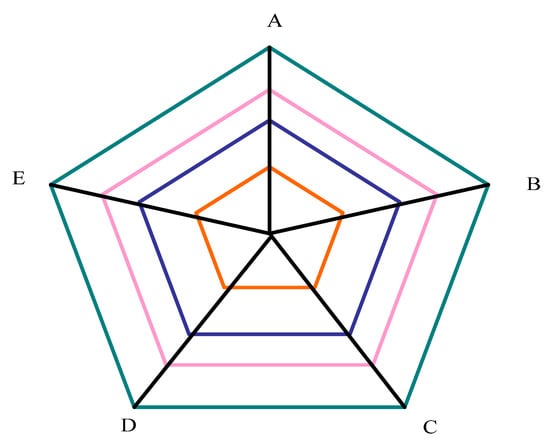
Figure 3.
TOPSIS method.
As shown in Figure 3, the evaluated schemes or objects are compared with the positive and negative ideal schemes one by one. If an evaluation object or scheme is closer to the positive ideal scheme and farther away from the negative ideal scheme, the evaluation scheme can be determined as the optimal scheme, and so on. In this way, the solutions are sorted according to their proximity. The specific calculation steps are as follows.
Assuming that there are n evaluation schemes, each scheme has m evaluation indicators, 1 represents the original value corresponding to the ith evaluation index of the jth evaluation scheme, and the original matrix is established as in Equation (3):
The original index values are standardized and the processed matrix is obtained as in Equation (4):
The positive ideal scheme and negative ideal scheme of the evaluation scheme are determined with Equation (5):
The distance between each evaluation scheme and the positive ideal and negative ideal schemes is calculated using Equation (6):
The degree of solution between each evaluation scheme and the ideal scheme, that is, the degree of closeness, is calculated as in Equation (7):
The closer the value of the final result is to 1, the closer the evaluated scheme is to the optimal scheme Euclidean clustering, and the better the comprehensive evaluation result is. From this, the priority ranking of each evaluation scheme can be obtained.
3.3. Construction of TOPSIS-GRA Comprehensive Evaluation Model
The TOPSIS method is a statistical analysis of the data of the project itself based on limited information. It has the effect of reflecting that the alternatives are close to the forward-looking ideal plan, but cannot show the changes of various factors between projects. The grey relational analysis method can explain the change of factors of project alternatives, as well as the difference between positive and negative ideal schemes when there is less information. However, this method has many defects in the overall evaluation of the system scheme. In view of the advantages and disadvantages of the two methods above, people try to combine the TOPSIS method with the grey relational analysis method. The entropy weight method is used to determine the index weight, so an improved grey ideal value approximation model is constructed.
The definition of the grey relational analysis method based on TOPSIS is as follows:
The evaluation scheme sequence is Equation (8):
The evaluation index sequence is Equation (9):
Next, the evaluation sequence consisting of the i scheme of the rth indicator is Equation (10):
The optimal reference sequence composed of the optimal value and the worst value of each evaluation index is Equation (11):
The constructed evaluation index system is a multi-level comprehensive index system. The units, dimensions, and digits of each evaluation index have various influences on the evaluation and decision-making results, and even lead to evaluation and decision-making errors. In order to unify the evaluation criteria of each index, the selected index must be processed dimensionless, which is Equation (12):
The i-scheme evaluation sequence of the normalized rth index is Equation (13):
To calculate the weights of the indicators, the weighting matrix is constructed as in Equation (14):
Among them, is the difference coefficient of the jth index.
After the weights are determined, the main diagonal matrix is constructed with the elements on their main diagonal as in Equation (15):
The grey relational degree is calculated as Equation (16):
As the concept of social responsibility has gradually attracted public attention, people’s awareness of social responsibility and environmental protection has been continuously enhanced. This not only makes enterprises strengthen their awareness of environmental responsibility, but also increases the public’s requirements for enterprises to disclose environmental-related information. Since then, with the passage of time, more and more companies have begun to issue social responsibility reports and disclose environmental information. Therefore, the specific content of environmental information disclosed by enterprises not only reflects the implementation of corporate social responsibility but also is the key point for the government to grasp environmental-related information and implement corresponding supervision in the production and operation of enterprises.
3.4. Establishment of Indicator System
The sustainable corporation law approach has three principles. One is to ensure environmental sustainability, that is, the long-term stability and resilience of the ecosystems that support human existence. The second is to promote social sustainability, that is, respect for human rights. The third is to meet economic sustainability, that is, to meet the socio-economic needs of stable resilience. Based on this, the “win-win” development of long-term corporate interests and social interests is promoted, as shown in Figure 4.
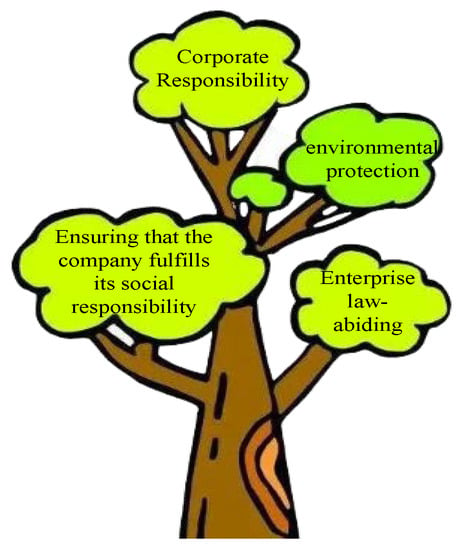
Figure 4.
CSR under the regulatory regime.
As shown in Figure 4, there are several basic principles that should be followed in the application of the CSR indicator system. One is the principle of timeliness, that is, the collection of indicator data must be carried out on time according to the requirement so that the indicators can reflect the latest development of the enterprise’s work in a timely manner. The second is the principle of accuracy, that is, the collection and processing of corporate social responsibility indicators should be strictly implemented in accordance with the requirements and should not be arbitrarily changed. It is necessary to ensure that the indicators can accurately reflect the basic situation. The third is the dynamic principle. The index system should not change in isolation but should be adjusted and perfected according to the constant changes in the internal and external environment of the enterprise, so as to accurately reflect the current situation of the enterprise. The fourth is the principle of flexibility. Corporate social responsibility activities must adhere to the policy of combining obligation and autonomy. By flexibly understanding the use of this metric, real-world changes are addressed and broken down into multiple types of metrics. The grey relational closeness is calculated using Equation (17):
The closer the final result is to 1, the closer the evaluated object is to the optimal solution and the better the effect. Through this TOPSIS-grey relational analysis model to evaluate the comprehensive ability of the sustainable corporation law pathway, the accuracy and scientificity of the evaluation results can be improved. It can be found that the stronger the comprehensive ability of the sustainable corporation law pathway, the better the enterprise can undertake social responsibility. On the contrary, only by better undertaking social responsibilities can enterprises achieve sustainable development.
3.5. Significance of Corporate Social Responsibility Regulatory System
- (1)
- Supervise enterprises to undertake social responsibilities in a timely manner
Social responsibility focuses on organizations and their responsibilities to society and the environment. Consumer issues, fair operating procedures, participation, and regional social activities are fundamental features of social responsibility. The social responsibility management system can provide a framework for enterprises, which can cause positive or negative effects, and can also prevent and control negative social consequences so that enterprises can better undertake social responsibilities. Responsible organizations should take effective preventive and protective measures to eliminate and reduce negative consequences and, where feasible, take positive actions to improve positive outcomes.
- (2)
- Provide reliable basis for enterprises
The undertaking of corporate social responsibility improves the relationship between the enterprise, the government, and society, forms a friendly interaction between them, and creates a broader living space for itself. In order to protect the environment, protect the interests of consumers, and maintain social stability, government departments recommend companies to take various action restrictions, sometimes accompanied by severe punitive measures. If enterprises can take the lead in taking social responsibility, they do not have to worry about the inspections and penalties related to this. In fact, this not only relaxes some restrictive clauses in the enterprise development process to a certain extent, but more importantly, it improves the flexibility and self-discipline of enterprise decision-making and operation.
4. Experiments Based on TOPSIS-GRA
4.1. Survey on the Status Quo of Corporate Social Responsibility
Recently, the business model of environmental sustainability has received more and more attention in the field of management, as well as from practitioners and stakeholders. The purpose of this study is to analyze the latest progress in this topic by reviewing the growing but mainly phenomenon-driven research. In particular, by identifying the main research trends and related gaps in the literature, and providing future research approaches, this paper promotes the debate on whether alternative business concepts are needed, which go beyond creating economic value for companies and creating value for society. This paper conducted the first comprehensive systematic review of business models in the field of environmental sustainability, carried out a detailed descriptive and critical analysis, and discussed future research opportunities. The undertaking of corporate social responsibility can promote enterprise innovation and realize the transformation of the economic growth mode. In the fiercely competitive market, only by guaranteeing product quality and safety, employee interests or regional social interests, the long-term stable growth and sustainable development of enterprises can only be ensured by relying on the competitiveness of products obtained by cheap labor. The state’s investment in social responsibility from 2014 to 2015 is shown in Table 1 (the data of this article comes from offline questionnaires and data from online sources).

Table 1.
State investment in social responsibility from 2014 to 2015.
As shown in Table 1, in 2014, other countries invested USD 15.2 billion in social responsibility, while China’s investment was USD 54.5 billion. In 2015, other countries’ investment in social responsibility was USD 19.9 billion and China’s investment was USD 60.2 billion. In 2016, other countries’ investment in social responsibility was USD 21.7 billion and China’s investment was USD 78.3 billion. In 2019, other countries’ investment in social responsibility was USD 48.9 billion and China’s investment was USD 87.9 billion. It can be seen that Chinese enterprises still pay more attention to social responsibility.
The definition time range of the research sample in this paper is from 2018 to 2019. Figure 5 shows the social responsibility commitment from 2009 to 2018.
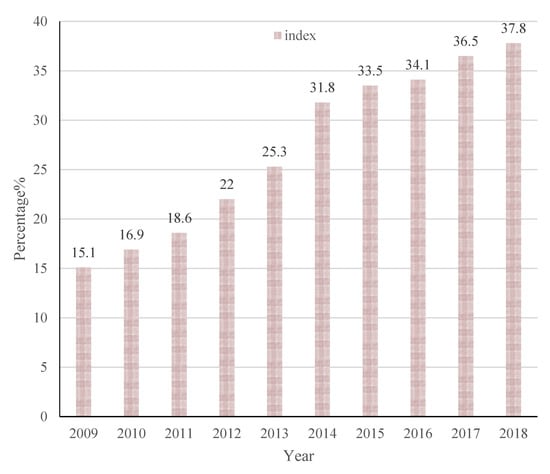
Figure 5.
Social responsibility commitment from 2009 to 2018.
The contribution rate of corporate social responsibility is equal to the total corporate social contribution divided by the total average assets. As shown in Figure 5, the index of social responsibility undertaking has been rising, but this does not mean that the overall awareness of corporate social responsibility in China has reached a high level. In reality, there are still many companies whose starting point for social responsibility deviates from altruistic motives. For example, a series of vicious incidents such as the “poisoned milk powder incident” have occurred frequently in recent years, which have triggered the public’s reflection on the ethics and morality of Chinese enterprises. Even the high-profile entrepreneurs who announced their corporate social responsibility have turned their charitable acts into charitable shows. The facts presented above show that the status quo of corporate social responsibility is not optimistic and deviates from its purpose and original intention. This must also cause people to reflect on what kind of social responsibility enterprises are undertaking.
In order to understand today’s enterprises’ views on social responsibility and whether it is necessary for them to undertake it, this paper conducts a survey on 150 enterprises. The basic information of these 150 enterprises is shown in Table 2.

Table 2.
Basic information of 150 companies.
As shown in Table 2, among the 150 companies, 142 are listed companies and 8 are non-listed companies. There are 35 companies with a business life of 1–5 years, accounting for 23.3%. There are 80 companies with a business life of 5–10 years, accounting for 53.3%. There are 35 companies with a business life of more than 10 years, accounting for 23.3%. Among them, 60% of enterprises have assumed social responsibility and 40% of enterprises have not. The percentage of enterprises that have undertaken social responsibility is higher but the difference is not large, which shows that supervision of corporate social responsibility is not in place.
In order to further understand the attitudes of enterprises towards social responsibility, the necessary degree of social responsibility considered by these 150 enterprises was investigated and analyzed, as shown in Figure 6.
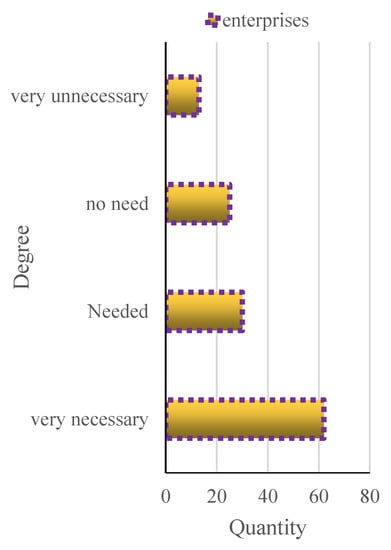
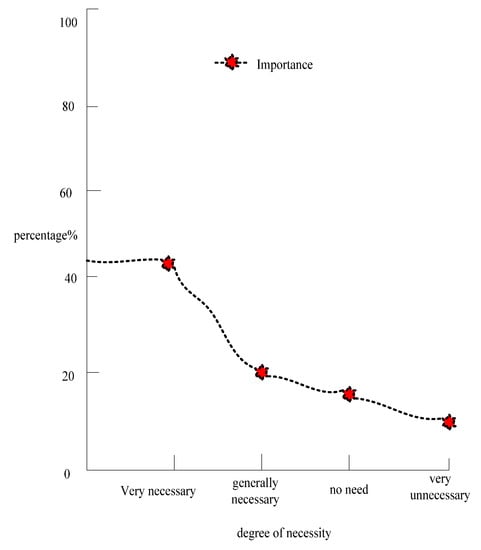
Figure 6.
The necessary degree of social responsibility considered by enterprises.
As shown in Figure 6, 62 companies believe that it is very necessary to implement a social responsibility regulatory system, accounting for 41.3%. There are 30 companies that think it is necessary to implement a social responsibility regulatory system, accounting for 20%. There are 25 companies that think it is unnecessary to implement a social responsibility regulatory system, accounting for 16.1%. There are 13 enterprises that think it is necessary to implement a social responsibility regulatory system, accounting for 8.6%. It can be seen that the implementation of a social responsibility regulatory system is considered necessary by most enterprises, so it has begun to be paid attention to.
4.2. Impact Experiment of Sustainable Corporation Law Pathway on Corporate Social Responsibility
In order to verify the effectiveness of the method proposed in this paper, the simple grey relational analysis and TOPSIS-grey relational analysis are compared on the evaluation accuracy, comprehensiveness and efficiency of six enterprises, as shown in Table 3 and Table 4.

Table 3.
Evaluation results of grey relational analysis.

Table 4.
TOPSIS-grey correlation analysis evaluation results.
The simple grey relational analysis and the TOPSIS-grey relational analysis are compared in Table 3 and Table 4. In the grey relational analysis, the highest accuracy of evaluation, comprehensiveness, and efficiency of evaluation were 66%, 58%, and 67%, respectively. In the TOPSIS-grey correlation analysis, the highest accuracy of evaluation, comprehensiveness, and efficiency of evaluation were 85%, 79%, and 87%, respectively. Therefore, the above results further verify the rationality and scientificity of the TOPSIS-grey relational analysis model for sustainable development evaluation.
After proving the comprehensive ability of the sustainable corporation law pathway, this paper analyzes the relationship between the sustainable corporation law pathway and social responsibility of enterprise A, as shown in Figure 7.
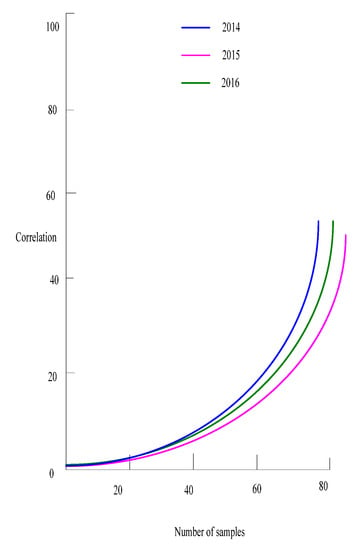
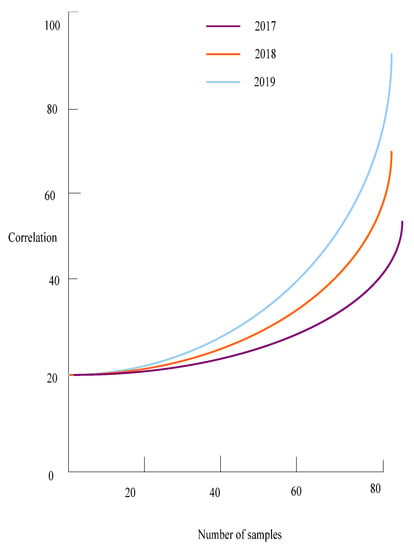
Figure 7.
The relationship between enterprise A’s sustainable corporation law pathway and social responsibility from 2014 to 2019.
As shown in Figure 7, the social responsibility variables are significantly correlated at the level of positive correlation. From this point of view, the variables are still statistically significant. In particular, the absolute value of the coefficient of the social responsibility variable in 2019 reached more than 80%, which indicated that the corporate social responsibility in 2019 was significantly positively correlated with sustainable development. The coefficients of social responsibility variables in each year are only lower in 2015 and some of the assumptions in this paper are proved. It can be seen that the impact of corporate social responsibility on the enterprise is a process. Undertaking social responsibility has a positive effect on the future development of an enterprise.
Only Chinese companies realize the importance of social responsibility. The current reasons for undertaking social responsibilities are more for the mandatory provisions of the law, or for some other purpose, enterprises occasionally undertake social responsibilities. There are very few capable enterprises that take the initiative to undertake social responsibilities unconditionally. This paper selects three companies that implement sustainable corporation law and three companies that do not implement sustainable corporation law (out 150 companies) to investigate their enthusiasm for social responsibility. The reason for choosing six companies is that they have different abilities to assume corporate responsibility. Some enterprises with good economic benefits will actively assume social responsibility, as shown in Figure 8.

Figure 8.
The enthusiasm of six companies to undertake social responsibility.
As shown in Figure 8, most scholars study the impact of corporate social responsibility on sustainable development, while few scholars study the impact of sustainable development on corporate social responsibility. It seems that the sustainable development of Chinese listed companies at this stage has little impact on their social responsibility. This model does not empirically prove that the sustainable development of enterprises promotes enterprises to undertake social responsibilities, but in general, well-developed companies are more capable of undertaking social responsibilities than poorly-developed companies. But as to whether these enterprises will use undistributed profits in the practice of social responsibility, it still depends on the development and operation strategy of the enterprise, its culture, the management philosophy of managers, and other factors.
Local governments use policies to guide and regulate the responsible behavior of enterprises, promote the legalization, standardization, and institutionalization of corporate social responsibility, and actively promote enterprises to fulfill their social responsibilities by gradually establishing market incentives, social supervision, and service mechanisms.
5. Conclusions
This paper believes that corporate social responsibility refers to the responsibility to maintain and promote social public interests including shareholders, creditors, government, employees, consumers, and communities while pursuing the maximization of the shareholders’ interests, so as to achieve the goal of social responsibility. Enterprises develop harmoniously with society and the environment to achieve a win-win situation for the economy, society, and ecology. The principle of sustainable corporation law pathway is to achieve sustainable economic, environmental, and social development. Therefore, this paper proposes to apply the concept of sustainable corporation law pathway to the regulatory system of corporate social responsibility. In order to evaluate the relationship between the sustainable corporation law pathway and social responsibility, a grey relational analysis algorithm is proposed that is useful to find the relationship between the two, and which finally determined that this relationship is complementary. Experiments are compared in the experimental part so that the conclusions are authentic and reliable. The results show that the evaluation accuracy of the grey relational analysis algorithm is over 80%. Therefore, the relationship between the sustainable corporation law pathway and social responsibility has been proven. The final experiment proves that corporate social responsibility affects the development of enterprises. By advocating enterprises to actively undertake social responsibilities, sustainable development is maintained. However, there are too few variables in the experiment of this paper, so the conclusion is not universal. Therefore, the research on the relationship between sustainable corporation law pathway and social responsibility needs more experience and knowledge to be completed.
Funding
This work was supported by Key Scientific Research in High Education of Henan Province, China, grant number 21A630012. This work was also supported by the Philosophy and Social Sciences Planning Project of Henan Province, China, grant number 2022BJJ140.
Institutional Review Board Statement
Not applicable.
Data Availability Statement
The data that support the findings of this study are available from the corresponding author upon reasonable request.
Conflicts of Interest
The author declares no conflict of interest.
References
- Kearins, K. Corporate Social Responsibility: The Good, the Bad and the Ugly. Soc. Bus. Rev. 2017, 34, 51–79. [Google Scholar] [CrossRef]
- Flammer, C. Competing for government procurement contracts: The role of corporate social responsibility. Strat. Manag. J. 2018, 39, 1299–1324. [Google Scholar] [CrossRef]
- Muslu, V.; Mutlu, S.; Radhakrishnan, S.; Tsang, A. Corporate Social Responsibility Report Narratives and Analyst Forecast Accuracy. J. Bus. Ethic 2019, 154, 1119–1142. [Google Scholar] [CrossRef]
- Gupta, A.; Briscoe, F.; Hambrick, D.C. Red, blue, and purple firms: Organizational political ideology and corporate social responsibility. Strat. Manag. J. 2017, 38, 1018–1040. [Google Scholar] [CrossRef]
- Vo, L.C. Corporate social responsibility and SMEs: A literature review and agenda for future research. Probl. Perspect. Manag. 2017, 9, 89–97. [Google Scholar]
- Berka, P. Comprehensive concept description based on association rules: A meta-learning approach. Intell. Data Anal. 2018, 22, 325–344. [Google Scholar] [CrossRef]
- Wang, B.; Chen, D.; Shi, B.; Zhang, J.; Duan, Y.; Chen, J.; Hu, R. Comprehensive Association Rules Mining of Health Examination Data with an Extended FP-Growth Method. Mob. Networks Appl. 2017, 22, 267–274. [Google Scholar] [CrossRef]
- Wang, Y.; Fu, P. Integration performance statistics of green suppliers based on fuzzy mathematics and BP neural network. J. Intell. Fuzzy Syst. 2021, 40, 2083–2094. [Google Scholar] [CrossRef]
- Zou, X. Analysis of consumer online resale behavior measurement based on machine learning and BP neural network. J. Intell. Fuzzy Syst. 2021, 40, 2121–2132. [Google Scholar] [CrossRef]
- Yang, Y.; Chen, L.; Xiong, Y.; Li, S.; Meng, X. Global Sensitivity Analysis Based on BP Neural Network for Thermal Design Parameters. J. Thermophys. Heat Transf. 2021, 35, 187–199. [Google Scholar] [CrossRef]
- Park, S.H.; Wan, S.S.; Kim, K.J. Assessing a social responsibility model for sustainable company growth in the Fourth Industrial Revolution. Int. J. Qual. Serv. Sci. 2019, 11, 334–345. [Google Scholar] [CrossRef]
- Ghani, E.K.; Jamal, J.; Puspitasari, E. Factors influencing integrated reporting practices among Malaysian public listed real property companies: A sustainable development effort. Int. J. Manag. Financ. Account. 2018, 10, 144–162. [Google Scholar] [CrossRef]
- Romney, L. In Good Company: How Workplace Inclusion Fuels Sustainable Growth. Forbes 2019, 202, 52. [Google Scholar]
- Windsor, J.; Garrod, T.; Tan, L. Progress towards a sustainable clinical academic training pathway. ANZ J. Surg. 2018, 88, 952–953. [Google Scholar] [CrossRef] [PubMed]
- Akkermans, B. Sustainable property law? Eur. Prop. Law J. 2018, 7, 1–3. [Google Scholar] [CrossRef]
- Calabrese, A.; Costa, R.; Menichini, T.; Rosati, F. Does Corporate Social Responsibility Hit the Mark? A Stakeholder Oriented Methodology for CSR Assessment. Knowl. Process Manag. 2013, 20, 77–89. [Google Scholar] [CrossRef]
- Carroll, A.B.; Shabana, K.M. The Business Case for Corporate Social Responsibility: A Review of Concepts, Research and Practice. Int. J. Manag. Rev. 2010, 12, 85–105. [Google Scholar] [CrossRef]
- Harwood, I.; Humby, S.; Harwood, A. On the resilience of Corporate Social Responsibility. Eur. Manag. J. 2011, 29, 283–290. [Google Scholar] [CrossRef]
- Maon, F.; Lindgreen, A.; Swaen, V. Designing and Implementing Corporate Social Responsibility: An Integrative Framework Grounded in Theory and Practice. J. Bus. Ethic 2009, 87, 71–89. [Google Scholar] [CrossRef]
Disclaimer/Publisher’s Note: The statements, opinions and data contained in all publications are solely those of the individual author(s) and contributor(s) and not of MDPI and/or the editor(s). MDPI and/or the editor(s) disclaim responsibility for any injury to people or property resulting from any ideas, methods, instructions or products referred to in the content. |
© 2023 by the author. Licensee MDPI, Basel, Switzerland. This article is an open access article distributed under the terms and conditions of the Creative Commons Attribution (CC BY) license (https://creativecommons.org/licenses/by/4.0/).